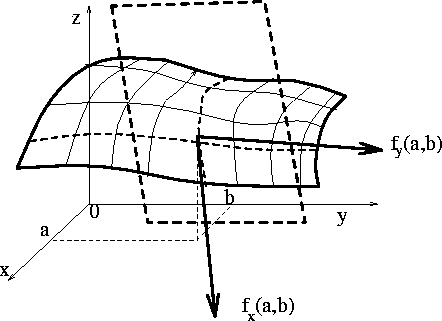|
We all have and intuitive idea of what the tangent plane to a point on a given surface should be. It is the plane that goes through
that point and that it is tangent to the surface at that point.
Suppose |

| Another way to define it is to say that this is the plane through the point (a,b,f(a,b)) which is perpendicular to the NORMAL to the surface at that point. The NORMAL to the surface at a point is just defined as the direction perpendicular to all tangent vectors to the surface at that point. Therefore all we need to do to find the equation of the tangent plane is to find a normal to the surface at that point. To find the normal notice that the position vector of points on the surface are given by: |
> r := (x,y) -> x*i+y*j+f(x,y)*k;
r := (x,y) -> x i + y j + f(x, y) k
| The tangent vectors to the coordinate curves r(x,b) and r(a,y) (these are the dashed lines on the surface above) when x=a and y=b are, |
> 'fx(a,b)' = subs(x=a,diff(r(x,b),x));
/ d \
fx(a, b) = i + |---- f(a, b)| k
\ dx /
/ d \
fy(a, b) = j + |---- f(a, b)| k
\ dy /
| These are the arrows tangent to the surface displayed in the above picture. A normal to the surface must be perpendicular to these two vectors so we can take the crossproduct of them to find it, |
> N := crossprod([1,0,D1f(a,b)],[0,1,D2f(a,b)]);
N := [ - D1f(a, b), - D2f(a, b), 1 ]
|
where we have denoted by D1f(a,b) the partial derivative of f with respect to x evaluated at the point x=a, y=b. D2f(a,b)
is the partial derivative of f w.r.t. y at (a,b). These
are just the coefficients of "k" in the expressions for
fx(a,b) and fy(a,b) resp. So we are done. The tangent plane must go through the point and have N as a normal. We know from our previous study of planes in 3D that the equation of the plane is given by: |
> TPlane := innerprod(N,evalm([x,y,z]-[a,b,f(a,b)])) = 0;
TPlane :=
- D1f(a, b) x + D1f(a, b) a - D2f(a, b) y + D2f(a, b) b + z - f(a, b) = 0
| The next three maple commands are just for displaying the above equation in the usual form. Notice how you can move things around in an expression with the commands, "isolate", "collect", "sort". |
> readlib(isolate): isolate(TPlane,z);
z = D1f(a, b) x - D1f(a, b) a + D2f(a, b) y - D2f(a, b) b + f(a, b)
z = D1f(a, b) (x - a) + D2f(a, b) (y - b) + f(a, b)
z = f(a, b) + D1f(a, b) (x - a) + D2f(a, b) (y - b)
| This is the equation of the tangent plane to the surface z=f(x,y) at the point x=a,y=b. |